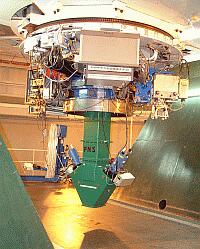First light (at ING): 16 July 2001.
Designed and built by: Anglo-Australian Observatory, Kapteyn Institute, the Netherlands, Mt Stromlo and Siding Springs Observatory, Australia, ESO, Garching.
Description: Planetary
Nebulae (PNe) are excellent probes of a distant galaxy´s rotational dynamics.
Through their strong [OIII] emission line at 5007Å rest wavelength
they can be easily detected and their radial velocity determined. In addition,
it is now widely accepted that their luminosity in the [OIII] line (for
an ensemble of PNe this is called the PNLF - Planetary Nebula Luminosity
Function) has a fairly sharp bright-end cutoff, which means that they can
be used as "standard candles" in determining distances. The PNS project
aims to build a dedicated Planetary Nebula Spectrograph in order to push
this technique to its limit.
Time allocations:
Nights scheduled since semester 2007B
Instrument information: http://www2011.mpe.mpg.de/opinas/research/DynamicsGroup/pns/index.htm
Research impact:
Scientific highlights (9)
Publications (12 from ING paper count)
Outreach:
Media releases (6)



